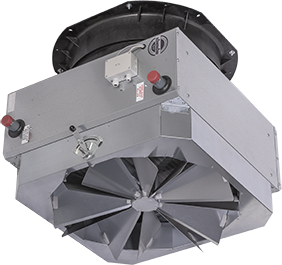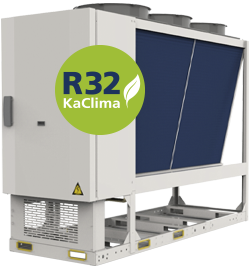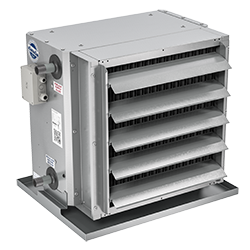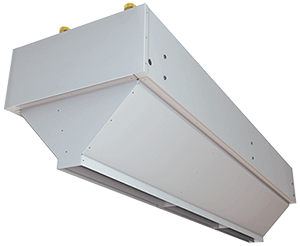Save energy costs with unit heater systems
It is crucial to plan ahead in our industry. The next heating season is just around the corner. We explain below how you can optimise the energy consumption of an existing unit heater system, possibly installed in an industrial shed, and prepare your customers for the colder months of the year. Use our handy hints, ideas and recommendations to reduce energy costs and the carbon footprint of the system to reach your customers' climate targets.
We also provide a view on modern unit heater systems, which have long since entered the ‘low temperature age’ with their intelligent controls and efficient EC fans.
But let's first look at what you can do if your customers are operating their industrial hall of shed with unit heaters and gas heaters. It's up to them to decide how far they want to go.
Step 1: Check the system temperatures and penetration depths.
Many systems are not ideally adjusted. Often the supply and return temperatures are unnecessarily high. Even dropping them just a few degrees can achieve significant cost and emission reductions. Check whether it is possible to reduce the supply temperature and test to what level it can be dropped.
It is also crucial that the heat arrives where it is needed: Is the penetration depth of the unit heaters sufficient? If this is not the case due to factors, such as fan performance or thermal up-currents from machines, it may be useful to increase the unit heater output or fit special louvres to increase the penetration depth. The KaMAX (Kampmann MultiAirMiX) accessory is available for Kampmann unit heaters, and can be retrofitted with ease.
The KaMAX diffuser features trapezoidal louvres arranged in a circle, with bearings on the inside and outside. The fins can be adjusted from the outside by means of a manual lever or actuator motor to direct the air as required. The penetration depth of the air can also be adjusted to suit requirements. The KaMAX diffuser thus provides for comfortable air distribution from the ceiling to the occupied zone, even in very high halls and sheds.
Step 2: Set an air recirculation rate of 1.8.
An air recirculation factor of 1.8 guarantees air circulation that effectively reduces the physically induced accumulation of heat under the ceiling of the hall or shed. The warm air under the roof is then transported to the occupied zone where people are sitting or working.
At this point, the advantages of unit heaters come into their own over surface heating systems, like radiant panels: the latter have no option of recirculating the warm air.
However, in order to achieve an air circulation rate of 1.8, it may be useful to add a few additional unit heaters to the system. As a rule, they are more efficient than existing unit heaters due to modern technical developments, especially the new EC drive technology. Nonetheless, new unit heaters can be combined with older model with ease.
Step 3: Add heat pumps to the system.
Take a significant step away from fossil-based energy with one or more heat pumps to supply the unit heaters with low-temperature hot water. Various funding programmes are also available in Germany. Your customers have the opportunity of stepping away from the use of gas when they use heat pumps. But even combining both systems helps to partially reduce their gas consumption.
The use of KaClima heat pumps also brings with it the benefits of indoor cooling. The TOP C is a unit heater in our range that heats with LPHW and cools in summer with CHW, also supplied by the KaClima chiller/heat pump. The comfortable hall cooling system helps to minimise tolerances and material expansion in production.
Modern unit heater systems
You have now progressed to step 3 and have thus seen the many benefits of a modern unit heater system combined with heat pumps/chillers. Of course, a completely new system takes advantage of and combines the advantages of modern developments best of all.
Intelligent control plays a significant role in this. Intelligent control can be fully exploited when unit heaters with EC technology are exclusively installed, which is now standard in the Kampmann unit heater range. The crucial factor here is its infinitely variable controllability with an optimum motor operating point across the entire unit heater fan speed range. The KaControl system then operates the unit within precisely the load range actually required, avoiding unnecessary energy consumption and saving operating costs in the long term.
EC motors are synonymous with efficiency and will thus also comply in future with the requirements of the European Union’s Ecodesign Directive for energy-related products (ErP).
At the same time, it also makes sense to consider other components, such as air curtains. ProtecTor air curtains, naturally equipped with continuously variable EC fans, create a powerful screen of cold air particularly across the large doorways of industrial buildings. So-called tandem technology, consisting of an unheated ambient air stream and a warm air stream, is so efficient that only one row of fans is required to effectively screen the cold air. This is also confirmed by our European patent.
Our three steps provide sufficient grounds for consideration. Do you require support or advice? We are always there to help. Find your Kampmann contact here.






